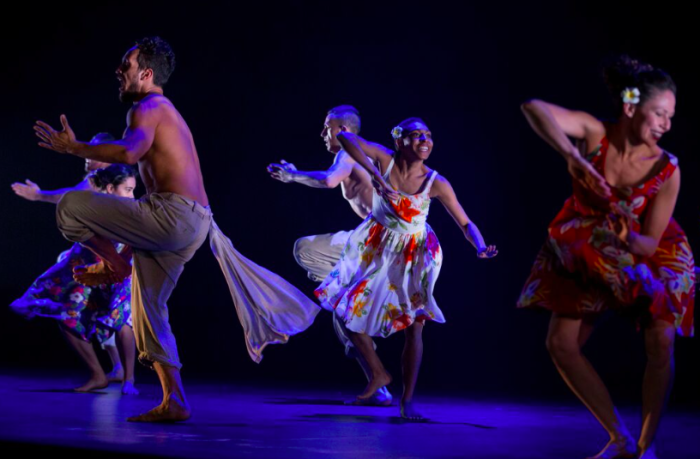The playful and enchanting “I.B.I.S”, created by first time choreographers Deborah Brown and Waangenga Blanco, charts the day of the contemporary hunters and gatherers of the Torres Strait Islands. The present is quickly established through the colourful shelves of a local “I.B.I.S”. store behind which the lone and resonant figure of Elma Kris, rhythmically mopping in preparation for opening time, suggests the resilience of tradition amid change.
As the full ensemble of dancers flows into and around the store, the girls’ bright floral dresses, the men’s white casual pants, the cheerful group singing and lively movements evoke a sense of a vibrant community, and remarkably, the sense of being warmed by a generous sun. The texture of this island culture is beautifully woven from several elements. The use of the spoken voice in Meriam Mer and Ka La Lagau Ya languages, group singing of traditional songs, the use of traditional instruments, the imaginative costuming and the strategic use of sound of the waves and birds, the wash of warm soft lighting and the long connection with water through the inclusion of the men’s boat, the “Mer”, in the turtle hunt.
While the whole was sensationally exuberant, there were highlights. The high-octane Sardine Song makes clever use of supermarket baskets, as later, the eerie blue light of the freezer displays the curiously disjointed beauty of the crayfish slyly emerging at night. The vigorous Neck Tie and delightful Cool Down in which the female dancers flirt with their appreciative audience, exhilarate through the sheer pleasure the ensemble take in performance. As a contrast the grace and innocence of the swimming turtles is unforgettable.
There is more to this dance piece than a brilliant evocation of modern-day island life. This fragile environment has survived displacement and has yet to survive the full repercussions of climate change. Its future resilience is strengthened through a continuing acknowledgement and recreation of lore, embodied at the close by Elma Kris, and as performed through “I.B.I.S.”.
The more abstract but deeply felt “Sheoak”, choreographed by Frances Rings, centres around the Grandmother Tree, provider of food, medicine, shelter and weapons. The sheoak, a symbol of the continuum of time: past in the roots, the present in the trunk and the future stretching out into its branches, is in crisis as many of the graceful casuarinaceae family are now listed as an endangered species.
The dance opens in a shadowy ancestral place, half-revealing a writhing mass of bodies as they rise, fall, emerge, shrink back, united by an invisible bond. As the dancers gradually separate each holds a long bleached bough, the close connection between tree and human invoked by the skeletal image they carry on their costumes. Under the dedicated guidance of the Keeper of the lore, Elma Kris, the full ensemble, wielding their branches, weave in and out and under in a mesmerizing ritual dance that culminates in an astonishingly powerful tableau of place and identity.
Displacement, the breaking down of connection and the uprooting of age-old sense of belonging, is effectively conveyed through a combination of dysfunctional movement, costume and icon. The hopeful searching seeds, so poignantly captured in the delicate movement of the female ensemble, have no place to grow. The destructive effect of displacement is inscribed on the bloodied skeletal prints of the male ensemble, and enacted through their reeling, directionless bodies, as they now collide with and even abuse the rootless, dangling trees.
However, it seems that although unity has been fragmented and connection to the invisible world of the ancestors lost, the spirit of the sheoak can be reborn through individuals reforging, recreating the lore. In another highlight of “Sheoak”, the ethereality but vitality of the spiritual dimension is sensitively conveyed through an illuminated, semi-transparent shape, that seems to float across the stage space, bringing with it hope of renewal. As the dancers reconnect with each other as caring individuals, the figure of the ancestral Keeper, the unseen guardian, is working behind a transparent screen to sustain and maintain the Indigenous peoples.
This illuminating and exciting program of dance is upheld and maintained by the skill and sensitivity of its musical scores, (David Page, “Sheoak” and Steven Francis, “I.B.I.S.”, the imaginativeness of its richly varied costumes (Jennifer Irwin), the sympathetic integration of lighting (Karen Norris) and stage design (Jacob Nash), and the overall guidance of Artistic Director, Stephen Page. The Bangarra dancers have once again “bodied” – such wonderfully expressive fingers and toes – the continuing renewal of Indigenous cultures in their authentic, unique and memorable way.





